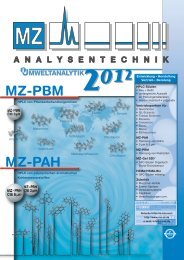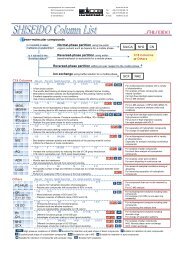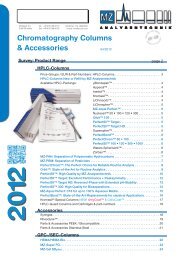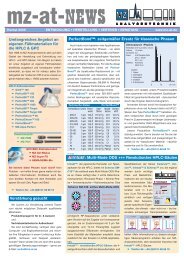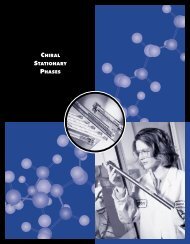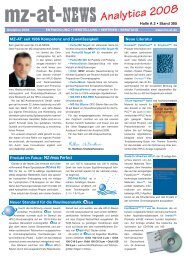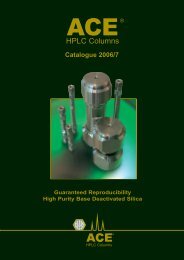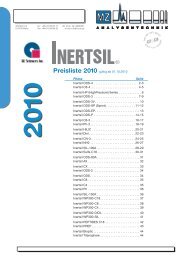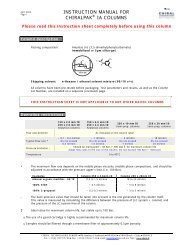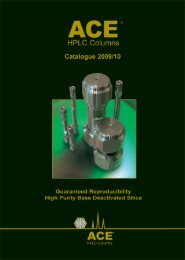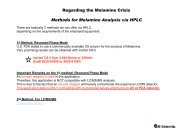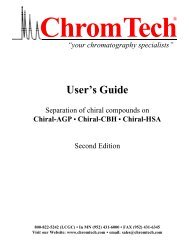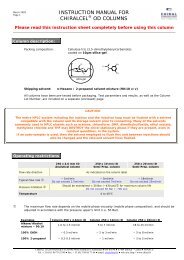You also want an ePaper? Increase the reach of your titles
YUMPU automatically turns print PDFs into web optimized ePapers that Google loves.
Sample volatility or thermal<br />
stability is crucial in GC<br />
applications. If a sample<br />
does not possess these<br />
important characteristics,<br />
GC analysis is highly<br />
unproductive. Derivatization<br />
techniques have been<br />
developed to address<br />
these issues to insure<br />
successful separations.<br />
In GC Derivatization,<br />
replacement of active<br />
hydrogen in functional groups,<br />
such as -COOH, -OH, -NH,<br />
and -SH, is the primary area of<br />
concern and is accomplished<br />
through either silylation,<br />
acylation or alkylation.<br />
GAS CHROMOTOGRAPHY (GC) DERIVATIZATION<br />
Silylation<br />
Silylation is the most widely used derivatization procedure for sample analysis by<br />
GC. Silylation reagents are popular because they are easy to use and readily form<br />
derivatives. In silylation, an active hydrogen is replaced by an alkylsilyl group, such<br />
|as trimethylsilyl (TMS) or t-butyldimethylsilyl (t-BDMS). Compared to their parent<br />
compounds, silyl derivatives are more volatile, less polar, and more thermally stable.<br />
As a result, GC separation is improved and detection is enhanced.<br />
Silylation reagents are generally moisture sensitive, requiring<br />
them to be sealed under nitrogen to prevent deactivation.<br />
The derivatives of TMS reagents are also moisture<br />
sensitive. In response to this difficulty, t-BDMS reagents<br />
were introduced, which enabled the formation of<br />
derivatives 10,000 times more stable to hydrolysis<br />
than the TMS ethers.<br />
Both TMS and t-BDMS reagents are suitable for a<br />
wide variety of compounds, offer excellent thermal<br />
stability and can be used in a variety of GC conditions and<br />
applications.<br />
Analysis by the popular combination of gas chromatography<br />
and mass spectrometry (GS/MS) often requires special sample<br />
derivatization. Particularly effective in these applications are MTBSTFA<br />
and deutero-MTBSTFA-d.<br />
Acylation<br />
Acylation reagents offer the same types of advantages available from silylation<br />
reagents: creating less polar, more volatile derivatives. However, in comparison to<br />
silylating reagents, the acylating reagents more readily target highly polar,<br />
multi-functional compounds, such as carbohydrates and amino acids. In addition,<br />
acylating reagents provide the distinct advantage of introducing electroncapturing<br />
groups, thus enhancing detectability during analysis.<br />
Generally, these reagents are available as acid anhydrides, acyl<br />
derivatives, or acyl halides. The acyl halides and acyl derivatives<br />
are highly reactive and are suitable for use where steric hindrance<br />
may be a factor. Acid anhydrides are supplied in a number of<br />
fluorinated configurations, which improve detection. These fluorinated<br />
anhydride derivatives are used primarily for Electron Capture<br />
Detection (ECD), but can also be used for Flame Ionization Detection<br />
(FID). Fluorinated anhydrides are often used in derivatizing samples to<br />
confirm drugs of abuse. Despite the special utility of these reagents, their<br />
acidic nature requires that any excess or byproducts be removed prior to<br />
analysis to prevent deterioration of the column.<br />
55



